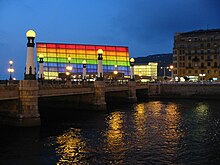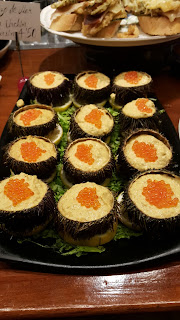When we arrived at the train station in Hendaye near San Sebastian, Spain, Hubby D struck up a conversation with a young couple from Colorado, S and H. They were staying in San Sebastian as well so we rode together on the local tram. Both of them had taken leave from their jobs and they were two and a half months into a 3-month journey in Europe. It was great to hear about their adventure.
We made an amazing connection with them. They first met each other in Steam Boat Springs, Colorado where Hubby D and I first met 38 years ago. It is a small world after all.

Kursaal Palace and Kursaal Bridge at night
 |
| Hotel Maria Cristina in San Sebastian. |
Towards the end of the 19th century, with the royal court of Madrid taking up summer residence in Donostia at the Palacio de Miramar (Miramar Palace), the city became a popular tourist destination and spa resort. Now there are surfers who flock to the city. Without the seasonal visitors, the population is around 180,000.
There was an old waterway directly in front of the hotel where the strong waves crashed against granite boulders and the tide pushed and pulled water. It was quite picturesque. We could walk out the beautiful 9-foot French doors to our small balcony and watch the waves.
 |
| The hotel was filled with beautiful flowers. |
 |
| The foyer had lovey chandeliers. |
 |
| The large bath had a nice shower and a big soaking tub. |
 |
| And, all was complete with 8 sided bidet and 8 sided toilet. |
Hubby D layered up with sweaters I had insisted he bring and he was comfortable. The hotel gave us large umbrellas and we stayed dry.
Our first evening we met with our new friends from Colorado and went to the “Old Town” where the pintxos (spelt with an ‘x’ in Basque, small dishes like tappas) are famous. Pintxos are unique to San Sebastian and a way of life for the locals.
The pintxo is a glorious, bite-sized snack, usually made up of something elaborate on a slice of bread and available strewn casually across every bar in the city, huge waves of bewildering food designed almost entirely to either get you through to a proper meal, or to soak up the wine or beer.
 |
| Some bar tops were even more loaded than this one. |
 |
| Looking in from the street. |
 |
| These are sea urchins. We did not try them. |
 |
| Along the way we added this beautiful basket of potatoes to the meal. |
 |
| This little boy was playing outside the door. He kept standing up and sitting down. The edge was the perfect height for him. |
There is etiquette to ordering pintxos.
Here is how it might go. You walk into a bar. It’s busy. There are people propped up at the bar, huge legs of jamon hanging from the ceiling. You have enough Spanish to order a couple of glasses of red wine. You probably spend half your time getting Spanish mixed up with the little Italian you know, and eventually end up asking in French.
There’s food everywhere, platters full of slices of baguette topped with ham, anchovies, sweet peppers, chorizo. It’s all quite bewildering, and feels like untrodden ground.
Finally you watch the other diners and realize you just point and the bar tender places your choice on a plate. He might even heat it up for you.
We discovered a local pintxo bar that had some very interesting waiters and pretty good pintxos. Hubby D read in an article about San Sebastain that a sign of a good pintxo bar was a lot of papers on the floor. This one fit the bill.
This is a video of the Gorriti Taberna. If you are reading this blog in an email, you will need to go to my blog page to see the video.
https://brendahyde.blogspot.it
Our stay on the Northern Basque coast of Spain was not all about food. Tomorrow we head to Bilbao to visit the Guggenheim Museum.
Cheers,
Brenda

















No comments:
Post a Comment